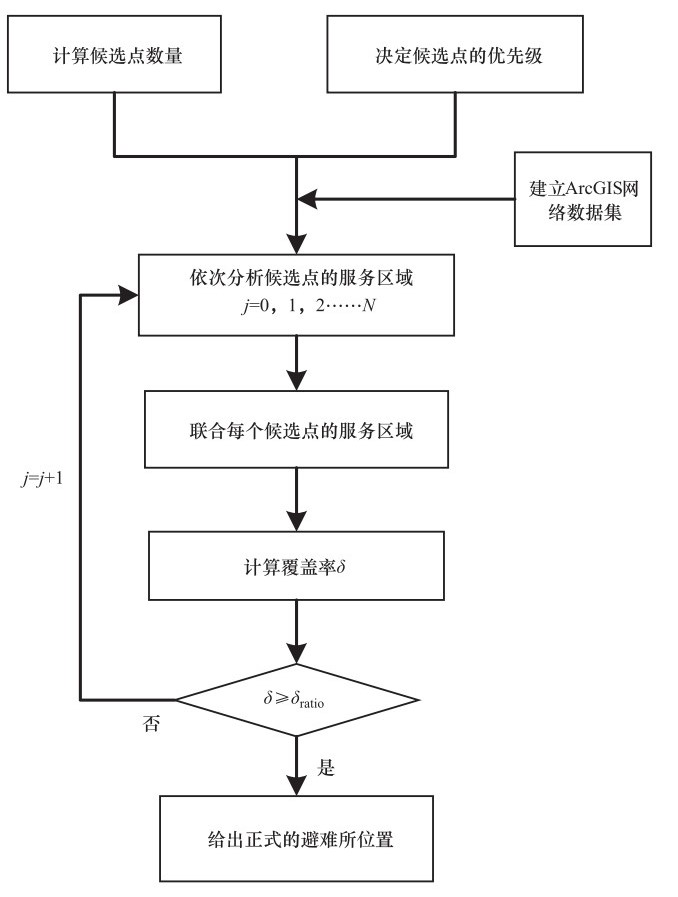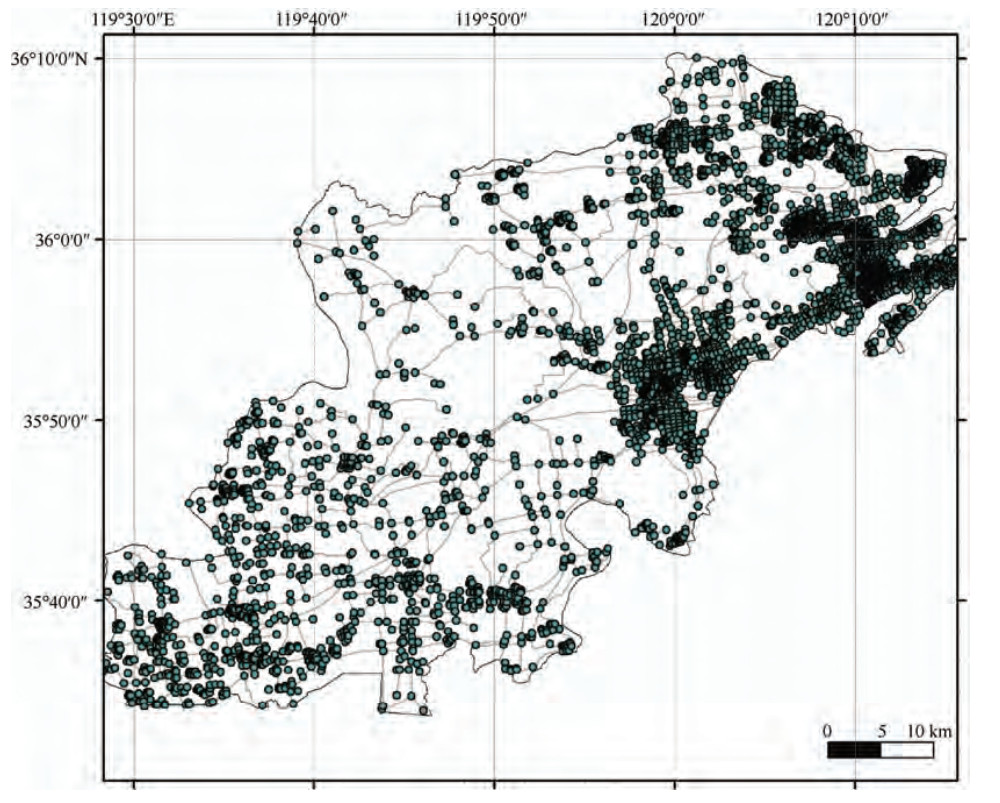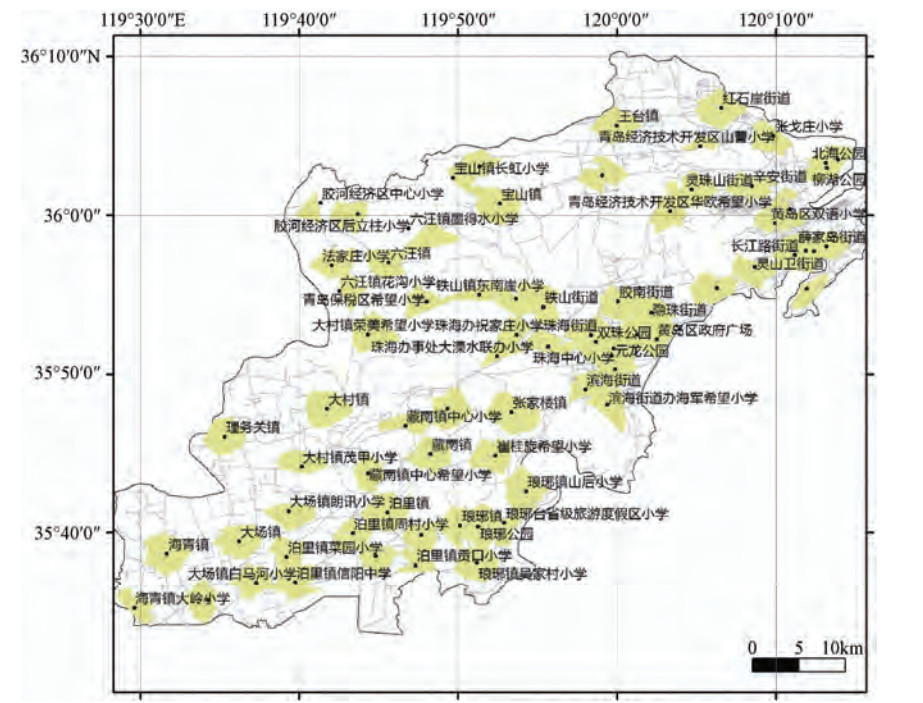Planning Multi-criteria Seismic Emergency Shelter Site Based on ArcGIS
-
摘要: 地震是极其严重的自然灾害,有可能造成重大伤亡和经济损失。由于城市中人口高度聚集,地震发生时,需将受灾居民快速疏散至应急避难所,因此,应急避难所选址的合理性至关重要。本文提出1种可用于解决选址问题的多准则选址模型,并提出了求解模型的方法。该方法分为3个步骤,首先选择候选应急避难所,其次分析候选避难所的服务范围,最后确定应急避难所的位置。通过案例研究,论证了多准则选址模型在地震应急避难所规划中的有效性。
-
关键词:
- 多准则 /
- 选址 /
- 地震应急避难所 /
- 地理信息系统(GIS)
Abstract: Earthquakes are extremely serious natural disasters, causing heavy casualties and economic losses. As the population in the city is highly concentrated, it is necessary to evacuate the disaster-affected residents to the emergency shelter once a disaster occurs. Therefore, the rationality of emergency shelter location becomes the focus of research. In this study, a multi-criterion constrained siting model is proposed to solve the siting problem. Then, an iterative method is proposed to solve the model. With the support of Geographical Information System (GIS), this method we developed consists of three steps: selecting candidate shelters, analyzing the space coverage of candidate shelters, and determining the location of the shelters. Finally, through case study, the application of the multi-criterion model and the effectiveness of the corresponding solutions in the planning of urban earthquake shelters are demonstrated. -
表 1 评价指标及评价权重
Table 1. Evaluation index and evaluation weights
评价指标 评价标准 建筑物的抗震水平 建筑物的抗震水平越高,安全系数越高 远离危险源 远离重大次生火灾源或危险爆炸源(不小于1km) 周围建筑物的高度 高层建筑物倒塌范围之外 有效性 研究选择避难所的入口数量、可容纳人口数和开放空间比 有良好的区位条件 避难所的分布应与人口密度相匹配 疏散通道与应急设施 与2条以上疏散通道相连,配备水、电设施 表 2 黄岛区现有避难所详细信息
Table 2. Details of existing shelters in Huangdao district
场所名称 地址 产权单位 建成时间 场地有效面积/m2 属性 容纳人数 市民文体广场疏散场所 黄岛区长江中路 区政府 2007 21000 广场 15000 双珠公园疏散场所 黄岛区双珠路 区政府 2015 70000 公园 30000 表 3 应急避难所信息
Table 3. Location information of emergency shelters
编号 避难所名称 有效面积/m2 人口容量 1 滨海街道活动广场 11280 3948 2 珠海街道活动广场 18000 6300 3 隐珠街道活动广场 13500 4725 4 铁山街道活动广场 13800 4830 5 胶南街道活动广场 15000 5250 6 灵山卫街道活动广场 12300 4305 7 六汪镇活动广场 11115 3890 8 长江路街道活动广场 13080 4578 9 薛家岛街道活动广场 25380 8883 10 宝山镇活动广场 8000 2800 11 灵珠山街道活动广场 10800 3780 12 辛安街道活动广场 11500 4025 13 黄岛街道活动广场 12500 4375 14 王台镇活动广场 22500 7875 15 红石崖街道活动广场 8900 3115 16 六汪镇花沟小学 13500 4725 17 法家庄小学 10600 3710 18 胶河经济区中心小学 16000 5600 19 胶河经济区后立柱小学 6500 2275 20 六汪镇墨得水小学 7000 2450 21 宝山镇长虹小学 8600 3010 22 宝山镇大张八小学 10300 3605 23 青岛保税区希望小学 11500 4025 24 铁山镇东南崖小学 7900 2765 25 铁山街道办事处中心小学 8000 2800 26 竞技体育运动学校 12000 4200 27 滨海街道办海军希望小学 13000 4550 28 黄岛区第二实验小学 8900 3115 29 黄岛区经济开发区海滨小学 9300 3255 30 黄岛区黄山经济区中心小学 8250 2887 31 青岛经济技术开发区华欧希望小学 8500 2975 32 灵山卫街道办事处赵家庙小学 7500 2625 39 柳湖公园 10300 3605 40 北海公园 9500 3325 41 市民文化广场 10300 3605 42 武夷山路公园 9600 3360 43 黄岛区政府广场 8600 3010 44 双珠公园 70000 24500 45 海青镇活动广场 10800 3780 46 大场镇活动广场 10250 3587 47 琅琊镇活动广场 10300 3605 48 泊里镇活动广场 7800 2730 49 藏南镇活动广场 8400 2940 50 理务关镇活动广场 7900 2765 51 张家楼镇活动广场 8300 2905 52 大村镇活动广场 9200 3220 53 海青镇大岭小学 9700 3395 54 海青镇徐家村小学 9100 3185 55 大场镇白马河小学 9600 3360 56 泊里镇信阳中学 8500 2975 57 大场镇朗讯小学 7900 2765 58 泊里镇董家口小学 9300 3255 59 泊里镇周村小学 9300 3255 60 泊里镇尹家村小学 8500 2975 61 泊里镇贡口小学 7600 2660 62 琅琊镇吴家村小学 8300 2905 63 琅琊台省级旅游度假区小学 12000 4200 64 琅琊镇山后小学 10600 3710 65 大村镇茂甲小学 6000 2100 66 藏南镇中心希望小学 11000 3850 67 张家楼镇河头小学 8000 2800 68 藏南镇中心小学 9000 3150 69 大村镇荣美希望小学 8000 2800 70 泊里镇菜园小学 15000 5250 -
陈志芬, 李俊伟, 卢方欣等, 2018.城市消防站选址布局优化及对雄安新区的启示.中国安全生产科学技术, 14(9):12-17. http://d.old.wanfangdata.com.cn/Periodical/zgzyaqwsgltxrz201809003 冯蔚, 朱林, 侯建盛等, 2016. 2014年全球地震灾害概要.震灾防御技术, 11(2):420-426. http://zzfy.eq-j.cn/zzfyjs/ch/reader/view_abstract.aspx?flag=1&file_no=20160226&journal_id=zzfyjs 高伟, 程家莹, 何宏林等, 2018.社区级地震应急避险场所分布的时空差异性评价——以北京丰台区长辛店地区为例.震灾防御技术, 13(2):447-459. http://zzfy.eq-j.cn/zzfyjs/ch/reader/view_abstract.aspx?flag=1&file_no=20180219&journal_id=zzfyjs 郭燕, 薄涛, 刘晓静, 2013.防震减灾能力评估方法及其在汶川地震中的应用.自然灾害学报, 22(5):36-43. http://www.wanfangdata.com.cn/details/detail.do?_type=perio&id=zrzhxb201305006 赖俊彦, 李亦纲, 杜晓霞等, 2015.新建社区的地震应急避难规划研究.震灾防御技术, 10(3):629-638. http://zzfy.eq-j.cn/zzfyjs/ch/reader/view_abstract.aspx?flag=1&file_no=20150317&journal_id=zzfyjs 潘强, 于平阳, 2018.加快新旧动能转换的措施建议——以青岛西海岸新区为例.中国经贸导刊(理论版), (5):48-49. http://www.wanfangdata.com.cn/details/detail.do?_type=perio&id=zgjmdk201805017 钱洪伟, 2017.城市应急避难所灾时运营研究进展与展望.灾害学, 32(1):160-165. doi: 10.3969/j.issn.1000-811X.2017.01.028 青岛市地震局, 2015.青岛市地震局2015年依法行政工作计划. (2015-01-16). http://dzj.qingdao.gov.cn/n12441301/n12443794/n12444036/151216135600030403.html. 青岛市统计局, 国家统计局青岛调查队, 2018-03-16(09). 2017年青岛市国民经济和社会发展统计公报.青岛日报. 史晓瑞, 商彦蕊, 胡佳等, 2016.石家庄市应急避难所适宜性评价.震灾防御技术, 11(3):656-666. http://zzfy.eq-j.cn/zzfyjs/ch/reader/view_abstract.aspx?flag=1&file_no=20160322&journal_id=zzfyjs 汤国安, 杨昕, 2012. ArcGIS地理信息系统空间分析实验教程. 2版.北京:科学出版社. 魏博, 刘敏, 张浩等, 2010.城市应急避难所规划布局初探.西北大学学报(自然科学版), 40(6):1069-1074. 吴健生, 郎琨, 彭建等, 2015.城市防灾避险功能的空间差异性评价——以深圳市经济特区为例.城市规划, 39(6):37-42. http://www.wanfangdata.com.cn/details/detail.do?_type=perio&id=csgh201506005 谢礼立, 曲哲, 2016.论土木工程灾害及其防御.自然灾害学报, 36(1):1-10. http://d.old.wanfangdata.com.cn/Periodical/sq-zh201804235 熊焰, 梁芳, 乔永军等, 2014.北京市地震应急避难所减灾能力评价体系的研究.震灾防御技术, 9(4):921-931. http://zzfy.eq-j.cn/zzfyjs/ch/reader/view_abstract.aspx?flag=1&file_no=20140421&journal_id=zzfyjs 张灿强, 张彪, 李文华等, 2012.北京城区绿地防灾避险功能评估.地理研究, 31(12):2301-2309. http://d.old.wanfangdata.com.cn/Periodical/dlyj201212017 中华人民共和国建设部, 2007. GB 50413-2007城市抗震防灾规划标准(附条文说明).北京: 中国建筑工业出版社. Liu Q., Ruan X. J., Shi P. L., 2011. Selection of emergency shelter sites for seismic disasters in mountainous regions:lessons from the 2008 Wenchuan Ms 8.0 Earthquake, China. Journal of Asian Earth Sciences, 40(4):926-934. doi: 10.1016/j.jseaes.2010.07.014 Nappi M. M. L., Souza J. C., 2015. Disaster management:hierarchical structuring criteria for selection and location of temporary shelters. Natural Hazards, 75(3):2421-2436. doi: 10.1007/s11069-014-1437-4 Rahmaniani R., Shafia M. A., 2013. A study on maximum covering transportation network design with facility location under uncertainty. Journal of Industrial and Production Engineering, 30(2):78-93. doi: 10.1080/21681015.2013.785447 Zhao X. J., Xu W., Ma Y. J., et al., 2017. Relationships between evacuation population size, earthquake emergency shelter capacity, and evacuation time. International Journal of Disaster Risk Science, 8(4):457-470. doi: 10.1007/s13753-017-0157-2 -




 下载:
下载:



